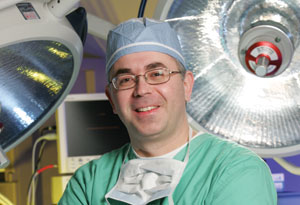Gut doctors
Gastroenterologists and surgeons collaborate for better patient care.

How treatment is coordinated at Monmouth Medical Center’s Minimally Invasive Esophageal Gastric Surgery Center? Steven A. Gorcey, M.D., chief of the Division of Gastroenterology, is in the middle of explaining when he receives a phone call that makes the point crystal-clear.
“Gotta run,” he says. “A patient of mine is in surgery, and Dr. Borao just called. He needs me to take a look.”
Hours later, Dr. Gorcey finishes describing how he and Frank J. Borao, M.D., surgical director and Monmouth’s chief of minimally invasive surgery, work together in ways not always found in other institutions.
“What happened just then is a perfect example,” he says. “Dr. Borao was in the middle of fixing a paraesophogeal hernia, in which part or all of the stomach bulges up through the diaphragm and into the chest. In that situation, there is a potential risk of injury to the esophagus or stomach during repair of the hernia. So he called me to go in with an endoscope [a thin tube with a light and a video camera] and determine if a leak was present. Being in the same center, I could just run down to the O.R. and help him out.”
In other settings, patients often bounce back and forth between the offices of the gastroenterologist, who does the diagnostic work and some endoscopic repairs, and the surgeon, who recommends and executes more advanced surgical procedures, says Dr. Borao. “We offer ‘one-stop shopping,’” he says. “It’s more efficient and there is minimal delay in patient management. When someone comes in, within a few days everybody is on board, plans are made and treatment commences. Otherwise it could take weeks.” Surgeons and gastroenterologists elsewhere don’t always work so closely, says Dr. Gorcey. “But Dr. Borao knows what I do best, and I know what he does best, so we work together. That’s the special ingredient that helps to make our center excellent. If I can’t do something, he can, and vice versa.”
The medical center’s team of gastroenterologists and general, thoracic and pediatric surgeons, along with registered nurses and registered dietitians, provides multidisciplinary expertise. “That also expedites things as we gather more opinions for the best procedures and plans,” says Dr. Gorcey.
“Our main purpose is to treat benign and malignant diseases of the esophagus and stomach,” says Dr. Borao. These include cancers, hernias, acid reflux, swallowing difficulties—and obesity, which can be addressed with bariatric weight-loss surgery. Most operations are now done laparascopically that is, with a minimally invasive approach that employs a thin, lighted tube with a video camera, introduced via small incisions.
“We have the best minimally invasive equipment in the country,” says the surgeon. “For our patients, that means shorter hospital stays, fewer complications such as infection and much less pain.”
“We do things that are typically done only at the most prominent teaching hospitals, not community hospitals,” says Dr. Gorcey, summing up. “This center is something very special that Monmouth Medical Center has and others don’t.”
A leader in weight-loss surgery:
Ten years at Monmouth Medical Center, Frank J. Borao, M.D., surgical director of the Minimally Invasive Esophageal Gastric Surgery Center and Monmouth Medical Center’s chief of minimally invasive surgery, performed the first bariatric weight-loss surgery in central New Jersey. In the decade since, he has helped make Monmouth the first choice for weight-loss surgery in the region.
Back then, gastric bypass was the only procedure available. Now he can also offer lapband surgery and revisional surgery to improve previous operations. And lately he has been offering a new procedure called sleeve gastrectomy, in which he removes a large part of the stomach while leaving the natural junctures at the esophagus and intestines intact. “It’s a hybrid between bypass and lap-band surgery,” he says. “You don’t need to reconstruct the intestine, and there is no foreign body inserted to close off the stomach as in a lapband approach. If the patient is uncomfortable having a band inside and is also afraid of reconstruction, this is right in the middle. And the results are very similar.” The overall bariatric program is successful, he says, because of its dedicated multidisciplinary team approach and the ongoing support programs it offers. “It’s not just the surgery and that’s it,” he says. “We follow you for life. I still see patients I operated on 10 years ago.”
A new approach to acid reflux:
For patients with acid reflux who don’t respond to medication or other treatments, Monmouth Medical Center’s Minimally Invasive Esophageal Gastric Surgery Center now offers a new, minimally invasive procedure that corrects the root cause of the condition: an anatomic defect at the junction between the esophagus and stomach. It’s called EsophyX (pronounced eeso-FIX), explains Steven A. Gorcey, M.D., chief of the medical center’s division of gastroenterology. And it involves sending an endoscope (a thin lighted tube with a video camera) through the mouth along with a surgical instrument that is used to stitch together openings smaller than 1 centimeter and thereby tighten the juncture. Clinical studies show that two years following the procedure, 85 percent of patients are still heartburn-free and 79 percent are still off daily medications.
“This is another option for patients who aren’t responding to other treatments,” says Dr. Gorcey. “And you don’t have to go to New York or Philadelphia for it—we’re doing it right here.”
To find out more about weight-loss surgery and the treatment of illnesses involving the digestive system at Monmouth Medical Center, please call 888-724-7123

